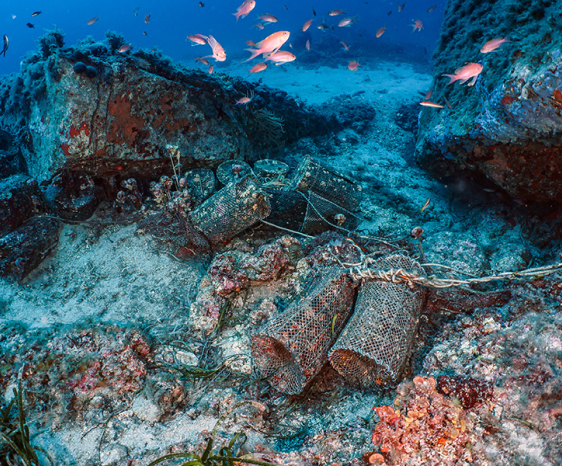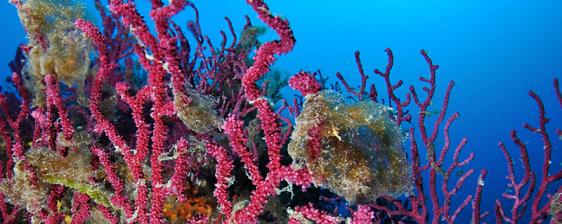Marine Protected Areas in Sardinia with Blue Marine Foundation
Critical Issues
70% of the surface of our planet is covered by seas and oceans, and only 30% by land. We owe this blue planet the production of more than 50% of the oxygen we breathe and the absorption of approximately 30% of the CO2 emissions generated every year by human activity and terrestrial pollution.
Italian waters are among the richest in biodiversity in the Mediterranean (representing 1% of the seas in the world): they host over 17,000 species and reach biodiversity values up to 10 times higher than the world average. If well managed and well connected, Marine Protected Areas (MPAs) can strongly contribute to preserving these species, the natural environments that host them, and restoring protected habitats, thus mitigating the effects of climate change.
However, the Mediterranean Sea is the most overexploited sea in the world, both in terms of overfishing (75% of fish populations are now overfished, and many are already at risk), and due to high maritime transport and poor management. of human activities (agricultural, industrial, disposal and tourism) that take place along the coastal strip, and which modify the coastline.
The phenomenon of ongoing climate change should not be underestimated, which has recently brought the increase in water temperatures to an all-time high of 31 degrees, and the rampant problem of microplastics and abandoned fishing gear, which in addition to killing wildlife and to degrade habitats, with the movements of the sea they are chopped up until they become an invisible mush (microplastics), reaching concentrations of up to 10Kg/Km2 in some areas. And since plastic is only shredded in 100 years, but never degraded, it is absorbed by fish as food, arriving on our tables.
Area of Intervention
Faced with this environmental degradation, the protection of Marine Protected Areas is fundamental. In order for a protected area to perform its function best and demonstrate the so-called 'reserve effects' (high values of biodiversity, biomass and abundance of species), it must be well managed against degradation and must not be too small in size. , and must be able to be connected to other neighbouring protected areas, in order to guarantee migratory species to find shelter during their entire life cycle.
The intervention area therefore involved a network of three Marine Protected Areas in Sardinia (Capo Caccia, Isola Asinara and Capo Carbonara-Villasimius), where we find heterogeneous habitats of valuable naturalistic interest and a rich faunal heritage.
The final objective is to improve its protection effectiveness, looking at the 2030 Agenda as the primary driver for the protection of Italy's marine heritage.
Intervention
Starting from January 2022, in partnership with our partner Blue Marine Foundation, a triple two-year project was launched which involves three Marine Protected Areas in Sardinia: Capo Carbonara (Villasimìus), Capo Caccia (Isola Piana) and Isola Asinara. The aim of the initiative is to expand and improve the management effectiveness of individual protected areas by promoting the conservation of crucial habitats and vulnerable species, according to current European guidelines (Habitat Directive 92/43 EEC) and the objectives of the 2030 Agenda.
Capo Carbonara Marine Protected Area
In the Capo Carbonara Marine Protected Area, the project carried out the removal and disposal of ghost nets and abandoned fishing gear. This type of waste is lost or abandoned by fishermen and, together with plastic waste, constitutes a significant source of pollution for crucial marine ecosystems, threatening protected marine species in worrying decline, such as the coral habitat and Posidonia oceanica meadows (a marine plant important for the production of oxygen and capable of offering shelter to species to grow and reproduce).
The results obtained from 2021 to 2024:
- The removal of waste from 6 sites was completed, for which approximately 33,156 m2 of seabed (approximately 3.5 ha) were searched/surveyed, of which 16,810 m2 (approximately 2 ha) were effectively cleaned by the presence of abandoned fishing gear/ghost nets and other waste.
- The University of Genoa assisted in before and after monitoring actions, using the BACI (Before, After, Control, Impact) method to verify the conditions of the seabed before and after the removal of the gear. Progressive improvement following the intervention was ascertained.
- The exact tonnage of waste collected was approximately 1,100kg (over one ton): approx. 1 km of fishing nets and a hundred pots as abandoned fishing gear (equal to 750 kg), and other types of plastic waste (equal to 330 kg).
- In January 2024, an infographic handbook was prepared on how to address and manage environmental problems of this type, and above all prevent them (to inform and combat the phenomenon of ALDFG - Abandoned, Lost or otherwise Discarded Fishing Gear) - material that can be disclosed in both English and Italian.
Marine Protected Area of Capo Caccia
The Marine Protected Area of Capo Caccia, which hosts the largest complex of sea caves in Italy (over 100, including the Nereo Cave, the largest in Europe), is a treasure of biodiversity. This area consists of precious habitats such as coral reefs and a variety of marine fauna, including protected species at risk of extinction such as the diadem urchin, the giant newt, the sea date and the porcelain cowrie. Unfortunately, over the years, the biodiversity of the area has suffered a strong impact due to free anchoring and unregulated diving tourism. The number of dives increased from 4,515 to 5,657 in five years (from 2018 to 2021), with a total of 20,913 dives in the five-year period, of which 70% in the MPA caves.
To combat this degradation, the Capellino Foundation together with the Blue Marine Foundation have undertaken targeted actions for the conservation of marine habitats and biodiversity. A system of 4 smart mooring buoys will be installed. This system will allow greater regulation of recreational diving activity and will protect the coral habitat adjacent to the entrance to the caves. Each buoy will protect 0.3 hectares, preserving a total area of 1.2 hectares in the Capo Caccia area. Among the species monitored with the University of Sassari in the coral area, we highlight Leptosammia pruvotii, Eunicella cavolini (yellow gorgonian), Corallium rubrum (red coral) and Axinella cannabina (calcareous sponge).
After 20 years from its establishment, the Park assembly has therefore approved a definitive regulation. This includes a new plan for mooring in the entire area of the MPA which will eliminate the phenomenon of free anchoring and specific guidelines for diving companies operating around the Capo Caccia promontory, in line with the objectives of our project.
Asinara National Park with its Marine Protected Area
From 2021 to 2024 we have dedicated ourselves, in collaboration with the Blue Marine Foundation, to the protection of the ecosystem of the Marine Protected Area (MPA) of the Asinara National Park.
This unique area combines the protection of a national park with the conservation measures of an MPA, providing a vital refuge for numerous species such as bottlenose dolphins, fin whales and the loggerhead turtle Caretta caretta.
Overfishing, or excessive fishing, is a growing threat to marine ecosystems around the world. At Asinara we have adopted new management measures for small-scale fishing, with more restrictive actions based on scientific data. In particular, through monitoring and strategies such as tagging (marking) of target species such as lobster, together with the definition of a plan for responsible harvesting and the creation of a quality brand of the fish caught by local fisheries, the excessive harvesting of animals that are not yet adults.
Thanks to the support of Fondazione Capellino and the Blue Marine Foundation, the Asinara project achieved exceptional results. Initially, an expansion of the protected area between 1,000 and 6,000 ha was envisaged, but a different decision was then reached: that of taking over and managing a much larger marine area, going from 10,800 hectares to over 66,000 hectares of protected area , and with a much more restrictive conservation line: the European one. In fact, since December 2022 a technical table has been created to improve management, and the Asinara Park has collaborated with the Sardinian Region and the Ministry of the Environment (MASE) to manage three Natura 2000 sites of community interest: the Isola dell 'Asinara, the Piana Island of Porto Torres and the area from the Asinara Island to Argentiera, an important ecological corridor for the species Tursiops truncatus (bottlenose dolphins). Now the protected area is 66,345 marine hectares.
The management of these sites of European importance will contribute to the 2030 Agenda objective of 30% protected areas (of which 10% strictly), ensuring effective management of natural systems. The agreement also provides for the updating of conservation measures, surveillance and control activities, and monitoring with the University of Sassari of priority habitats and species (mainly represented by cetaceans, seagrass meadows and coral habitats).
At the same time, in January 2024, the Sardinia Region, through the MASE, formally approved the start of the creation of the "Cross-border Biosphere Reserve at sea" between Sardinia and Corsica, the first ever in the Mediterranean. It is located between the three MPAs of Northern Sardinia - Asinara, Capo Testa and Maddalena - and the Bocche di Bonifacio in the south of Corsica. The UNESCO Man and Biodiversity (MaB) Program will help conserve biodiversity and promote sustainable socioeconomic development.
Discover More
www.bluemarinefoundation.com/2022/03/29/blue-marine-launches-ambitious-campaign-to-connect-marine-protected-areas-in-italy/
www.bluemarinefoundation.com/projects/italy/


%20(1).jpg?width=2000&height=1333&name=Nasse_abbandonate+Parazoanthus%20(1)%20(1).jpg)
Our Partner
Blue Marine Foundation is an English foundation dedicated to promoting Marine Protected Areas, tackling overfishing by developing responsible small-scale fishing models and restoring marine habitats, thus bringing the oceans back to health, whose degradation is among the world's major environmental problems. By fighting the distorting phenomena of the blue planet, we help life in the ocean to carry out its fundamental function of stabilising the earth's climate and connecting people and new generations to the sea, promoting knowledge and respect for it.
Project data
 |
DURATION 2 years (01/01/2022 – 31/12/2023) |
 |
OUR INVESTMENT €144,000.00 (of which €72,000 - 50% from the Foundation Capellino) |


